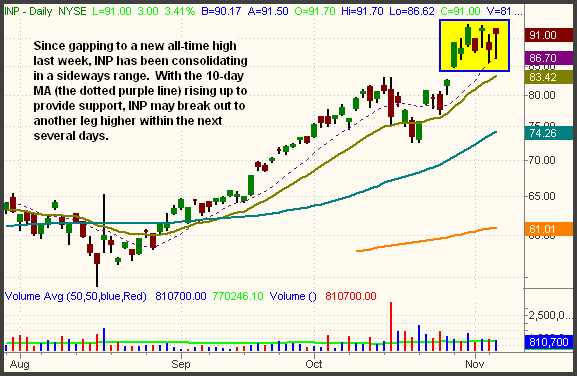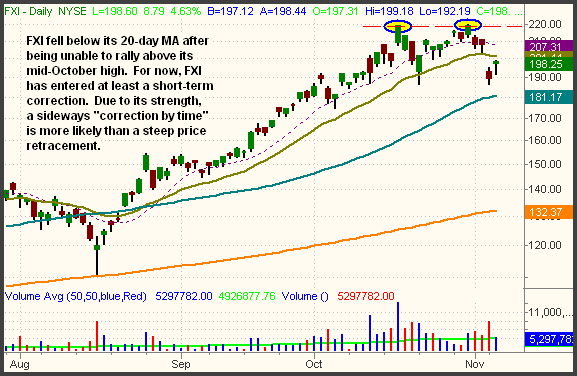| The Wagner Daily ETF Report for November 7 |
| By Deron Wagner |
Published
11/7/2007
|
Stocks
|
Unrated
|
|
|
|
The Wagner Daily ETF Report for November 7
After gapping higher on the open, sellers took control yesterday morning, but the bulls arrived at lunchtime, pushing stocks back towards their morning highs. A more intense wave of buying in the final forty-five minutes of trading pushed the major indices to new intraday highs. Thanks to strength in the oil sectors and a bounce in financials, the S&P 500 outperformed the Nasdaq for a change, albeit by just a narrow margin. The benchmark S&P 500 Index gained 1.2%, while the Nasdaq Composite advanced 1.1%. The blue-chip Dow Jones Industrial Average rallied 0.9%. The laggard Russell 2000 and S&P Midcap 400 indices bounced 1.5% and 1.3% respectively. Overall, yesterday's price action was on par with the intraday seesaw action we've become accustomed to lately, but this time the main stock market indexes closed nearly at their best levels of the day.
Although it gained slightly less than the S&P yesterday, the Nasdaq turned in the better performance "under the hood." Total volume in the Nasdaq increased 21% over the previous day's level, enabling the index to score a bullish "accumulation day." The firmly higher volume shows institutions had a healthy appetite for leading stocks within the Nasdaq. Turnover in the NYSE also rose, but only by a marginal 3% increase.
The Oil Service HOLDR (OIH), which we discussed as a bullish setup in yesterday's commentary, was one of the strongest ETFs in the market. Cruising 3.4% higher yesterday, OIH moved firmly above resistance of its three-week downtrend line. A resumption of the long-term primary uptrend is now under way, but be cognizant of the price action as it tests its mid-October high (around the $204 area). If OIH was purchased on yesterday's breakout, we would consider a protective stop just below yesterday's low, as that would also be below new support of the prior downtrend line.
In the October 30 issue The Wagner Daily, we illustrated how the iPath India (INP) was beginning to show relative strength to the iShares Xinhua China 25 (FXI). Within the international sector, we mentioned that INP was likely to surpass FXI as the top performing ETF. Since then, this has clearly been the case. The "percentage change" chart below shows the relative performance of INP vs. FXI since our October 30 commentary:

Over the past week, FXI has pulled back 7.21%. But during that same period, INP has rallied nearly 4%. That represents a difference of approximately 11% since our initial mention of the rotation out of FXI and into INP. More importantly, INP is likely to continue outperforming because it is forming a bullish consolidation on its daily chart. Conversely, FXI has just entered at least a short-term correction. This is illustrated with daily charts of both INP and FXI below:


If INP rallies above the high of its consolidation ($92.57), we will probably buy it. The mid-October correction below its 20-day MA means it could move a lot higher before another significant correction is necessary. For six weeks from September through mid-October, notice how INP only dipped down to its 10-day MA (the dotted purple line) before resuming its uptrend to new highs. The 20-day EMA didn't even come into play until October 16, when INP printed a big red candle that took it down to that level. A clear breakout above its recent consolidation may set in motion another similar uptrend, especially with the relative strength INP is now exhibiting to the other international ETFs. As for FXI, it is simply taking a rest, but is best avoided until it moves back to its high. We do not advocate short positions in FXI unless it breaks firmly below its 50-day MA and then bounces.
Yesterday's broad-based rally put the S&P 500 back above its 50-day MA, but the index remains in danger of breaking below its October low and testing its 200-day MA. The same is true of the Dow, which did not rally back above its 50-day MA. Within the main stock market indexes, the small-cap Russell 2000 remains the weakest link. Having undercut its October low in each of the past two days, the Russell is technically in a confirmed intermediate-term downtrend. The "head and shoulders" pattern the index is trying to complete is bearish as well. Though discussed less frequently than the S&P, Nasdaq, and Dow, the Russell is nevertheless an important proxy for the health of aggressive growth stocks. Opposite of the relative weakness in the Russell is the relative strength in both the Nasdaq Composite and Nasdaq 100 indices. The Nasdaq brothers clearly have the healthiest chart patterns of all the major indices.
Open ETF positions:
Long - TWM
Short - (none)
Deron Wagner is the Founder and Head Trader of both Morpheus Capital LP, a U.S. hedge fund, and Morpheus Trading Group, a trader education firm launched in 2001 that provides daily technical analysis of the leading ETFs and stocks. For a free trial to the full version of The Wagner Daily or to learn about Wagner's other services, visit MorpheusTrading.com or send an e-mail to deron@morpheustrading.com.
|